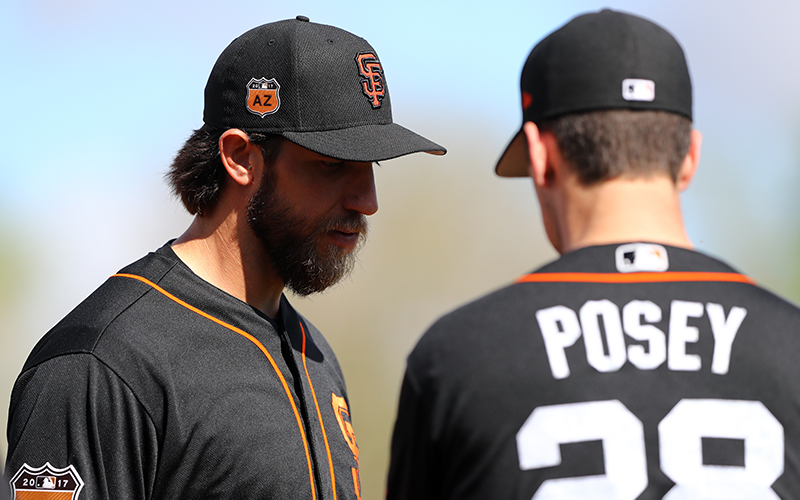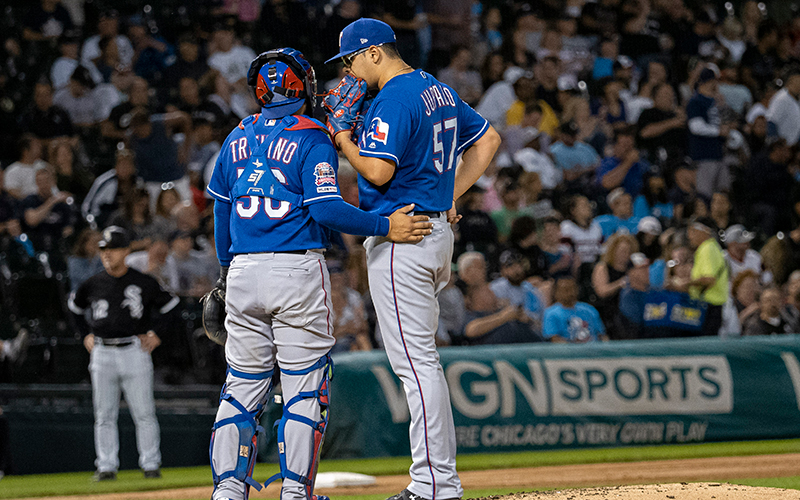SURPRISE – In early March, Texas Rangers pitchers and catchers would frequently walk from their clubhouse to the back fields together, talking and laughing. The moments symbolized how important the relationship between pitcher and catcher is in baseball, similar to a marriage, where communication is key.
Among the nuances impacted by the postponement of the Major League Baseball season due to the COVID-19 pandemic is the bonding that occurs between battery-mates during spring training. This season’s workouts were cut short by two weeks.
“Knowing them, knowing their pitches, knowing their stuff, knowing their tendencies, knowing what they like to do, the signs they like, there are a list of things I can keep naming,” Rangers catcher Jose Trevino said. “I think the relationship is a two-way street. Just keeping the communication going.”
The connection between pitcher and catcher is key to a successful outing on the mound. In fact, they are brought to spring training before other position players so the relationship can start early.
In baseball, a battery isn’t like that lithium-ion cell used to power modern electronic devices. On the diamond, the pitcher and catcher make up a “battery,” the term derived from military batteries of artillery weapons that dates to the 1860s, according to baseballjournal.com. In comparison to electrochemical cells, however, a baseball battery does power a team. And they produce a special wavelength that connects arguably the two most important players on the field.
Eighty-three pitchers and 19 catchers have been elected into MLB’s Hall of Fame in Cooperstown, New York, according to baseballhall.org. Among them is the most widely celebrated battery: left-hander Whitey Ford and catcher Yogi Berra, a top-notch pair for the 1953-63 Yankees.
Other standout pitcher-catcher duos include the Athletics’ Lefty Grove and Mickey Cochrane, the Yankees’ Mariano Rivera and Jorge Posada, and the Cardinals’ Adam Wainwright and Yadier Molina.
In fact, St. Louis pitching coach Mike Maddux was so blown away by the connection of the Cardinals’ duo he told MLB.com it was “telepathy.”
One of the top recent pairs was Madison Bumgarner and Buster Posey of the San Francisco Giants. Bumgarner signed with the Diamondbacks in December and will see if he can find similar magic in Arizona.
Pitchers and catchers are often seen together and many believe spending time off the field is just as important as the time on it.
“It’s just little things like going to dinner,” Rangers catcher Nick Ciuffo said. “You might go to Buffalo Wild Wings after a game, get some wings, hang out. You just talk and get to know your guys.
“For me, over the years, it’s really knowing your pitchers, who they are on and off the field and being able to use that to help them be their best on the field.”
Spring training is an important time for batteries as It allows them to learn each other’s strengths and weaknesses before the regular season starts. Once it does, some players will be sent down to the minors, not seeing each other again unless one of them is called up or if the roster expands at the end of the season.
“That’s why you’ve got to have communication and talk to them when it’s not their days to catch,” Rangers right-hander Lance Lynn said. “You got to get to know them, they got to get to know you. We have a good staff here that makes sure they catch everybody, whether it’s bullpen or stuff like that.”
After working with a variety of pitchers for 15 seasons, former Diamondbacks catcher Jeff Mathis often gives advice to younger players about handling the rotation.
“You have to know what pitches they throw, what pitches they are doing,” said Mathis, now with the Rangers. “Also, being able to handle them in high pressure situations once stuff starts to get tense, how you talk to guys who have different personalities. For me, it’s so big and it’s something I use spring training (for), to make sure we get that established.”
When he arrived in Texas, Ciuffo asked Mathis what has kept him in the big leagues for so long. Mathis emphasized it was important to keep the dialogue open, spending time with pitchers on and off the field.
“As far as homefield goes,” Mathis said. “It’s like every time that I get a chance to catch a bullpen or be around the rest, we talk about what the pitchers are doing or what I am setting up. All those things are very important to me and important to that relationship.”
Rangers pitcher Luke Farrell, whose dad is former MLB pitcher, coach and manager John Farrell, knows how important the relationship is with catchers. He said it is almost like mind-reading, where the catcher knows what kind of pitch he will be throwing.
“Each guy likes to pitch differently,” Farrell said. “I like to change on the fly and try to be unpredictable with my pitches. Some relievers throw two, I happen to throw four. Just having a greater number of pitches makes it more difficult. The guys we have in camp are awesome. They pick up quick what you are trying to do. I am lucky to have good catching out here.”
The connection doesn’t always come easy. Players get traded, or leave because of free agency.
Last season, several notable trades occurred involving pitchers and catchers. From July 13 to July 31, 2019, 61 pitchers and four catchers were involved in trades, not including players to be named later, mlb.com reported.
“I try to be with all the catchers we have,” Lynn said. “We try to talk with them so you never know when something might happen.
“With the way the game is now, catchers move in and out, whether it’s game by game basis, you really can’t be relying on a catcher like you were in the past.”


